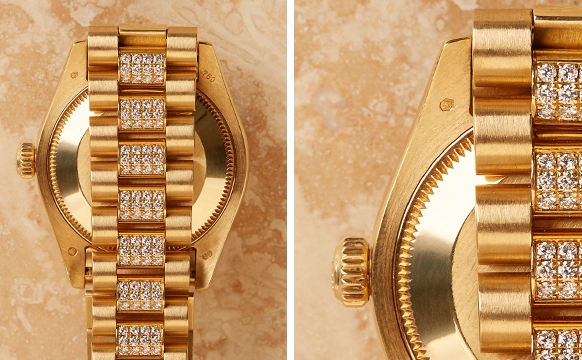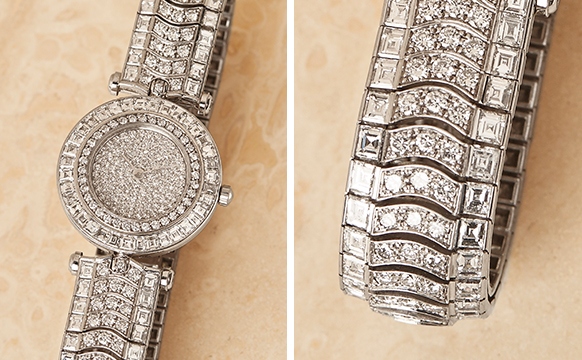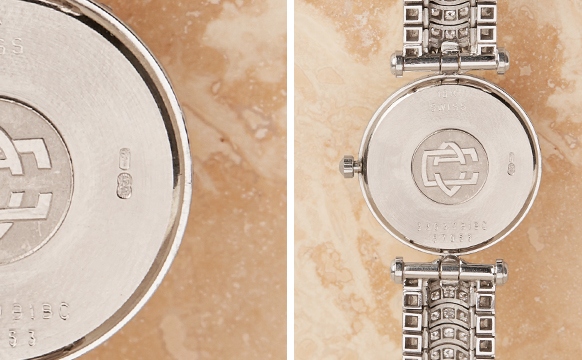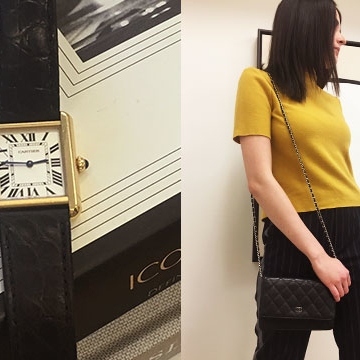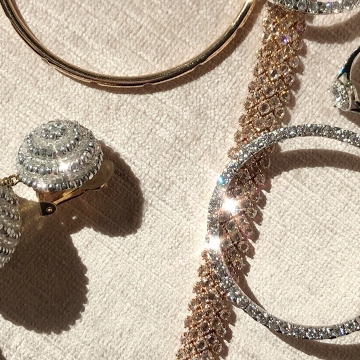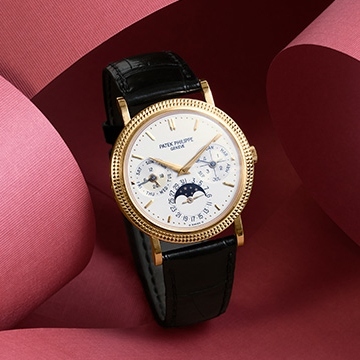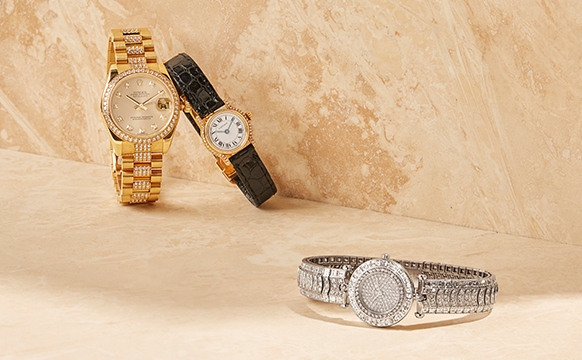
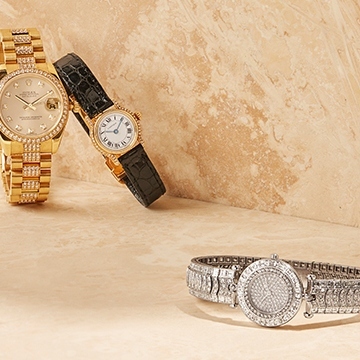
How to Spot (and Invest In) a Real Diamond Watch
Out of all the exceptional, luxe pieces we receive here at The RealReal, nothing quite compares to a diamond watch. A marriage of brilliant stones, refined timekeeping and a little magic, diamond watches hold an elusive charm akin to that of the iconic Birkin handbag. But how do you know which sparkling timepiece is right for you, and how can you tell a genuine diamond watch from its faux counterpart? Read on as Katherine Ward, Senior Valuations Manager, Fine Jewelry & Watches, shares how our experts determine which diamond watches are the real deal, authentication tips on select top-tier brands and how to find your perfect stunning timepiece.
Once The RealReal receives a diamond watch, what kind of authentication process does it undergo?
First and foremost is a close inspection of the watch, and setting it to observe how it keeps time. While it ticks away, we consider everything from the movement and materials to the maker. Diamonds add a welcome layer of complexity to authenticating and assessing a watch. A diamond watch may be a superlative example of master watchmaking, featuring rare complications and diamonds to complement its technical artistry. It may also be a stunning diamond pavé bracelet that just happens to tell time.
Either way, all timekeeping aspects are carefully examined by our team of watchmakers, and the 4 Cs of the diamond — cut, color, clarity and carat — are evaluated along with the setting techniques employed in making a watch. Using instruments like a Witschi machine — an ultra-sensitive microphone designed to listen to the “heartbeat” of a watch — our horologists examine them inside and out.
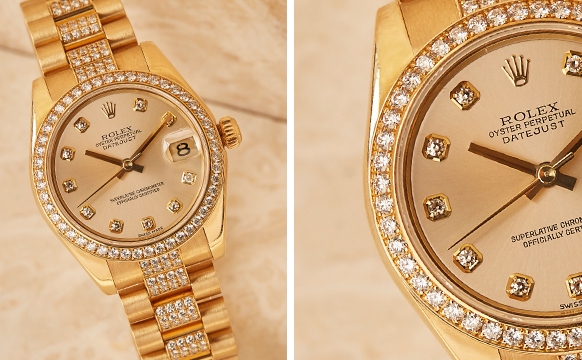
Rolex Watch Authentication Tip: Iconic Rolexes like this Datejust use diamonds of IF (Internally Flawless) clarity, indicating there are no inclusions (i.e. impurities) visible under 10x magnification.
When it comes to timepieces, what are the standards or ideal grades for diamonds?
The same 4 Cs that gemologists evaluate in diamond jewelry make the difference in diamond watches. Every brand chooses their standards carefully. Rolex, for example, insists on diamonds of D through G color and IF clarity in their current production, and uses single cut diamonds — a simpler, earlier version of the modern round brilliant cut diamond featuring 17 facets instead of the the round brilliant cut’s standard 57 facets — as hour markers.
This minimal facet arrangement is anachronistic in the average watch produced today by any brand. Rolex’s standard requires all diamond markers to be single cut diamonds, which is a handy authentication tip exclusively for Rolex (and best observed under magnification). If a Rolex under review features round brilliant markers, it’s a sign that aftermarket diamonds may have been added, and does not reflect Rolex’s original design.
Since aftermarket diamonds are often inconsistent with brand standards, we don’t accept any watches with aftermarket diamonds. This attention to detail à la Rolex shows the care and consideration taken to ensure that each of these diamonds are not only of high quality, but of consistent, matching, harmonious quality.
Rolex Watch Authentication Tip: Look for crisp, clean stamps on genuine Rolexes. The Common Control Mark (CCM) at bottom right indicates this watch was produced in post-1972 Europe. The stamp at top left, a miniature Saint Bernard head in profile, narrows the production location and date to Switzerland, 1995 or later.
What are the telltale signs that a diamond watch is fake?
The authentication team sometimes jokes about a “sixth sense” for inauthentic pieces, but there is a grain of truth to the myth. As experts we see dozens of watches in a given day, and develop trust in our gut instincts. Trust, always verified with solid evidence.
Each watch brand has its own methodology, caveats and quirks that have evolved over the years, but when examining a diamond watch, we use loupes, microscopes, UV lamps, GIA-compliant diamond color grading cards, master stones and other standard tools. Our team inspects a watch carefully to determine its authenticity, condition, and if any components, from diamonds to replacement parts, are aftermarket additions — elements added after the watch left the maker and not reflective of the designer’s intention (and therefore, not accepted at The RealReal).
Van Cleef & Arpels Watch Authentication Tip: Authentic Van Cleef & Arpels diamond watches, like this Classique style, feature diamonds that are carefully selected to match one another, involving an exhaustive search to compare hundreds or even thousands of stones. Watch out for diamonds that seem inconsistent with others in the same piece.
How has the diamond watch evolved throughout history?
During the 1700s, personal watches were owned almost exclusively by men as the most sumptuous of luxury items. Pocket watches were a status symbol reserved for the highest of the elite, and decorated with diamonds of similar scarcity in the European market.
As watches became more easily affordable and attainable in the late 1800s and early 1900s, their design and role for men became utilitarian, featuring fewer stones except in the rarest and most elaborate of timepieces. Women’s watches were incorporated into jewelry pieces such as brooches, chatelaines worn at the waist or long chain necklaces. Discoveries of new mines meant diamonds were more available to a growing middle class eager to demonstrate their elevated position in society.
In the early-to-mid 1900s, diamonds were almost exclusively featured on women’s watches, though in the second half of the 20th century men’s timepieces began to once again feature more diamonds, in some cases completely pavéed. Often diamonds are implemented by designers to elevate the aesthetics of the watch to the same high level of the mechanics of the movement inside. But regardless of the brand that produces it, a quality diamond watch is crafted carefully with aesthetics, durability and utility in mind.
Van Cleef & Arpels Watch Authentication Tip: The combination of this watch’s CCM and the small lady in profile indicates it is 18 karat gold, and produced between 1972-1995, which lines up with the watch’s style and execution.
Which brands are heavy hitters in the fine watch industry, and why?
It all comes down to craftsmanship, craftsmanship, craftsmanship. The same values that houses like Cartier, Rolex and Van Cleef & Arpels bring to jewelry-making feature prominently in their success as watchmakers. Designers like Piaget and Chopard are also well-known for their diamond watches, and have a tradition of delivering an elegant, meticulously executed product.
Precision is crucial in both jewelry and watch production, best exemplified by Rolex’s aforementioned high standards. On Van Cleef & Arpels watches, for example, the care taken in construction is visible on watches with link bands, seen above. The open space behind each diamond if often referred to as ‘A jour’ work, an open window that lets in the light of day. Overall, each brand’s adherence to their own precise standards is essential to how we authenticate and refine our archive and knowledge base about each maker.
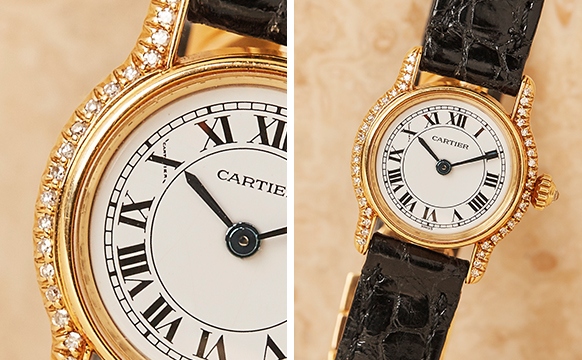
Cartier Watch Authentication Tip: Note that Cartier watches (like this Vendôme model) with roman numeral markers hide a brand secret: the logo in miniature comprises part of the X at ten o’clock in this authentic Cartier watch.
What should someone consider when investing in a diamond watch?
How and when will you wear it? Does the statement you have in mind demand wall-to-wall diamonds, or maybe the slightest sparkle? Gold and platinum are typically associated with dress watches for more formal occasions, while steel is practical for every day.
If you want something iconic yet understated, you can’t go wrong with a Cartier Tank watch. Cartier employs diamonds of excellent color and clarity, each set meticulously by hand. The craftsmanship of the setting of each stone speaks to time and attention to detail. Looking for an excellent watch movement and just a few diamond accents? Opt for a sleek Jaeger-LeCoultre.
Patek Philippe produces premium timepieces that feature expert watchmaking, and are perfect heirlooms to pass down from generation to generation. And if you’re interested in full-blown bling, go for something spectacular from Harry Winston. These design houses all have great resale value, and are perfect contenders for consignment if you decide to move on to something new in the future.
Stay on time in style. Shop our curated selection of diamond watches here.
All items are pre-owned and consigned to The RealReal. Trademarks are owned by their respective brand owners. No brand owner endorses or sponsors this ad or has any association and/or affiliation with The RealReal.
Please note: Brand standards, logos and other identifying features may have changed since the time of publication.


